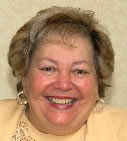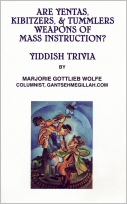  
|
  
|

The Yiddish word "vunderlekh" means wonderful.
Halloween is rapidly approaching and what comes to mind are Erma Bombeck's seven FATSU commandments ("Aunt Erma's Cope Book"):
#4: THOU SHALT NOT STEAL HALLOWEEN CANDY FROM THY CHILDREN.
Orthodox Jews do NOT celebrate Halloween. The main concern about Oct. 31, stem from Pagan roots and Halloween's possible association with divination and idolatry.
Rabbi Jeffrey W. Goldwasser [About.com] was asked whether it's OK for Jews to celebrate Halloween. He replied--in part-- "There is no religious reason why contemporary Jews should not celebrate Halloween as it is commonly observed by dressing in costumes, giving children candies and other treats, and by taking our own children out to 'Trick-or-Treat.' As a secular holiday, Halloween should be no more problematic for Reform Jews than Thanksgiving or the Fourth of July. Halloween's focus on fright and death can be a good opportunity for talking to young children about their fears, although it should not be taken to excess."
So, kids, it's time to make "di kokoshes" (the popcorn) and watch the 1978 movie, "Halloween II," starring Donald Pleasence and Jamie Lee Curtis. Note: It's rated "R"; bring out the "rugelach!"
The Zagat Movie Guide had the following to say about the movie:
"Changing the face of horror movies forever," this almost bloodless chiller shows that gore doesn't equal terror" ("shrek") as it depicts a "masked psycho stalker" who preys on "rowdy teens"; despite 'zero- budget' production value and so-so acting (but mighty "great screaming by Jamie Lee"), this "influential slasher" flick spawned a slew of sequels and "still holds up" simply because it's so "genuinely scary."
I tend to agree with Roger Ebert: "Things You Would Never Know Without the Movies":
1. If staying in a haunted house, women should investigate any strange ("modne") noises in their most revealing underwear ("untervesh").
2. There-Goes-the-Neighborhood ("shkheyneshaft") Rule. In horror movies, no matter how many ghostly apparitions or psychokillers appear in a house, the owners will not leave it. In fact, the more scared they get, the more determined they are to stay put. Apparently they're earning some kind of "scream equity." See Amityville Horror, etc. Raphael Carter, Tempe, AZ (Source: "Ebert's Bigger Little Movie Glossary")
3. Undead Dead In horror movies, whenever the killer is killed, he is never dead. This rule is as old ("alt") as the movies, but was given its modern shape in Halloween (1978), when the killer arose from apparent distraction to jump up ("shpringen") behind Jamie Lee Curtis. Since then, all of the Dead Teenager ("tsenerlingn") movies, most of the Bond pictures, and many other thrillers have used a false climax, in which the villain is killed--only to spring up for a final threat..." (Roger Ebert, "Ebert's Bigger Little Movie Glossary")
Beverly Sills and Lawrence Linderman,("Beverly - An Autobiography") describes what took place in the fall of 1973. Beverly Sills flew out to CA to sing La Traviata in San Francisco. (She appeared as Violetta.) Kurt Adler was the conductor and was more "nervez" (nervous) than anyone in the cast. The rehearsals were full of "shpanung" (tension/anxiety). Kurt kept his head buried in the score; he almost never looked up at "di bine" (the stage). This lack of eye contact, drove everyone "meshuge" (crazy/nuts).
Sills writes, "During our dress rehearsal, the first act seemed more like a funeral than a party. I decided to break the tension in a way that would also break Kurt's habit of not keeping an eye on his singers.
That dress rehearsal happened to be on HALLOWEEN. At the start of the third act, I came onstage wearing one of those Groucho Marx get-ups--eyeglasses, a big plastic nose, and a moustache. The chorus and the singers already onstage brokeup, but at least five minutes passed before Kurt became curious as to why everyone was laughing. When he finally looked up, he started laughing as hard as everyone else. I walked over to the edge of the orchestra pit and said, 'You ought to look up here every once in a while. You're missing all the fun.' After that, Kurt looked up at us a lot, and his nervousness about conducting again disappeared completely."
-----------------------------------------
Marjorie Wolfe lives about 20 minutes away
from Amityville, New York, the home of the "Amityville Horror." It's a peaceful
enclave on Long Island's South Shore.
There stands no other case in the latter
part of the 20th Century that so captured
"di fantazye" (the imagination) of the
general public--and no other case that
filled us with such "shrek" (fear). Could
ghosts destroy a family the way that "beyz"
(evil) spirits did to George and Kathy Lutz?
"Lomir redn fun freylikher zakhn." (Let's talk about more cheerful things.)
| A | B | C | D | E | F | G | H | I | J | K | L | M |
| N | O | P | Q | R | S | T | U | V | W | Y | Z |


| Yiddish
Stuff Jewish Humor Schmooze News More Majorie Wolfe |
Principle Jewish Stories All Things Jewish Jewish Communities of the World |